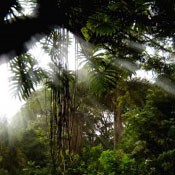Busy Week For UN REDD Programme Policy Board And Forest Carbon Partnership Facility As Jurisdictional Efforts Ramp Up
The UN REDD Programme Policy Board approved $35.5 million in readiness funding, including allocations to the national programs of Argentina, Cote d’Ivoire and Mongolia. Meanwhile, the World Bank’s Forest Carbon Partnership Facility accepted Chile and Vietnam into its REDD pipeline, and provisionally accepted Peru.

This article was originally published in the Forest Carbon newsletter. Click here to read the original.
16 July 2014 | Ecosystem Marketplace’s third installment of our Palm Oil vs The Peatland Forest series is now live. In it, we meet Todd Lemons, an ‘ecosystem entrepreneur’ who, as a 20-something, found himself in the Bolivian rainforest sourcing hardwoods for major American furniture dealers. After finding beautiful pieces of mahogany in the scrap pile, Lemons implemented a “cut-to-size” program that required less wood for more furniture and developed an obsession with using sensible economics to address environmental challenges.
Years later, in 2007, he found himself in Borneo driving through a patchwork of palm-oil plantations and second-growth native forests on his way to Tanjung Puting National Park, a massive lowland peat swamp that has been amassing carbon for 10,000 years. Lemons didn’t know it at the time, but the trip was the first step in developing the Rimba Raya REDD (Reducing Emissions from Deforestation and Degradation of forests) project that would hold off the encroaching palm oil developers and prevent the annual release of more than 3.5 million tonnes of carbon dioxide.
“We know now that peatland has about eight times as much carbon per hectare as a typical rainforest of the Amazon,” says Heru Prasetyo, the head of Indonesia’s REDD Task Force. “Back in 2007, no one really knew.”
As Steve Zwick reports, though, REDD didn’t create an “incentive” to save the forests. A typical palm-oil plantation generates $1,000 per hectare in pure profit – more than twenty-fold the income that could be generated from the sale of offsets. So REDD will not sway those responding to purely economic incentives, but it does create a financing mechanism that may make it possible for people who want to save forests to do so. The Rimba Raya project has sold five million tonnes of offsets since 2010 and verified another five million tonnes of emissions reductions, more than four million of which remain unsold.
The full series of stories will be available here.
And for the fifth year running, Forest Trends’ Ecosystem Marketplace is collecting data about forest carbon projects around the world to include in our State of the Forest Carbon Markets 2014 report. This is the only market-wide, freely available research tracking performance-based payments for emissions reductions in forests, and we rely on a global survey to ensure that our data is representative.
Help us spread the word!
Our survey for forest carbon project developers is available in English HERE (http://survey.ecosystemmarketplace.com/forestcarbon2014/) and in Spanish HERE http://survey.ecosystemmarketplace.com/es_forestcarbon2014/)
Responding to the survey is also the best way to get your project information updated on the Forest Carbon Portal, a hub of information for potential investors, researchers, and other market participants. We’re building a community there, and if you haven’t already, we’d love for you to join us. Once you do, your profile will appear in our Member Directory, and you will be able to post projects, jobs, and events on the Portal.
What else? Do you want to be able to message other members? Start discussions? Announce new project developments? Well, that’s up to you. Send us a note and let us know what you’d like the Forest Carbon Portal membership community to be/do, and we’ll try to make it happen.
â€â€The Ecosystem Marketplace Team
If you have comments or would like to submit news stories, write to us at [email protected].
![]()
![]()
|
|
|
ABOUT THE FOREST CARBON PORTAL
The Forest Carbon Portal provides relevant daily news, a bi-weekly news brief, feature articles, a calendar of events, a searchable member directory, a jobs board, a library of tools and resources. The Portal also includes the Forest Carbon Project Inventory, an international database of projects including those in the pipeline. Projects are described with consistent ‘nutrition labels’ and allow viewers to contact project developers. |
|
ABOUT THE ECOSYSTEM MARKETPLACE
Ecosystem Marketplace is a project of Forest Trends, a tax-exempt corporation under Section 501(c)3. This newsletter and other dimensions of our voluntary carbon markets program are funded by a series of international development agencies, philanthropic foundations, and private sector organizations. For more information on donating to Ecosystem Marketplace, please contact [email protected].
|
Click here to read this article in its original format.
Please see our Reprint Guidelines for details on republishing our articles.

